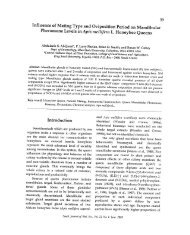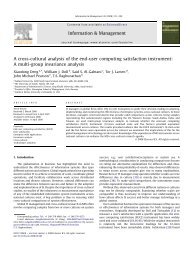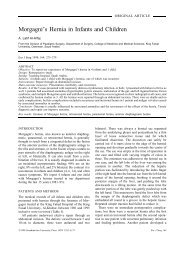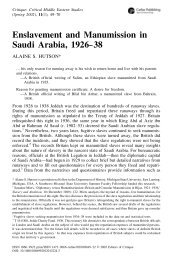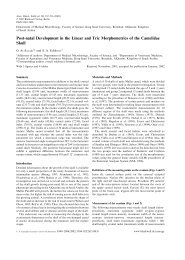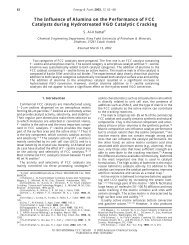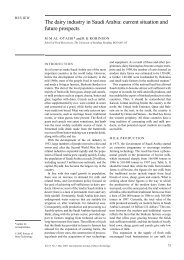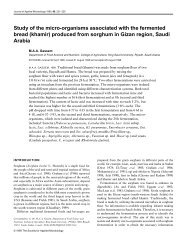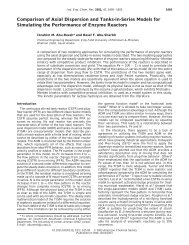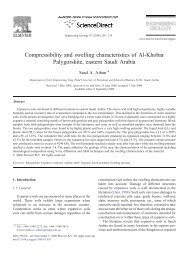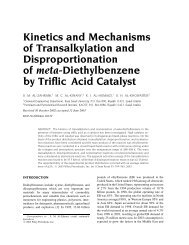Role of racemization in optically active drugs development
Role of racemization in optically active drugs development
Role of racemization in optically active drugs development
You also want an ePaper? Increase the reach of your titles
YUMPU automatically turns print PDFs into web optimized ePapers that Google loves.
458 ALI ET AL.<br />
Fig. 3. Rapid changes <strong>in</strong> S/R enantiomer concentration ratio with<strong>in</strong><br />
first m<strong>in</strong>ute after racemic flobufen adm<strong>in</strong>istration <strong>in</strong> rat. 87<br />
were reported <strong>in</strong> the same range. Further, <strong>in</strong> 1996 Schmahl<br />
et al. 93 studied the <strong>racemization</strong> <strong>of</strong> EM 12 enantiomers <strong>in</strong><br />
monkey, rat and mouse. R- and S-Enantiomers showed their<br />
appearance <strong>in</strong> embryo <strong>of</strong> marmoset monkey, wistar rat and<br />
NMRI mouse <strong>in</strong> organogenesis duration. The gestation day<br />
<strong>of</strong> monkey, rat, mouse were 61, 12, 10 respectively. The<br />
presence <strong>of</strong> EM 12 enantiomers was reported <strong>in</strong> maternal<br />
plasma, placenta and embryo <strong>in</strong> marmoset monkey and<br />
wistar rat. Low concentrations <strong>of</strong> EM 12 metabolites were<br />
identified <strong>in</strong> plasma and embryo <strong>of</strong> rat and monkey, evaluat<strong>in</strong>g<br />
the teratogenic effect <strong>of</strong> parent drug. Cuyue et al. 94<br />
reported that blood samples <strong>of</strong> rat have only S-stiripentol<br />
[(S)-STP] after oral adm<strong>in</strong>istration <strong>of</strong> [(S)-STP]. But with a<br />
same dose <strong>of</strong> [(R)-STP], samples showed the presence <strong>of</strong><br />
both R- andS-enantiomers <strong>in</strong>dicat<strong>in</strong>g the <strong>racemization</strong> <strong>of</strong> Rform<br />
only. The authors also suggested the entry route <strong>of</strong><br />
chiral <strong>in</strong>version <strong>of</strong> stiripentol R-enantiomer. After oral dose<br />
<strong>of</strong> any enantiomer <strong>of</strong> the drug, the authors observed that<br />
drug has become enriched with R-form; dur<strong>in</strong>g the course<br />
<strong>of</strong> <strong>in</strong>test<strong>in</strong>al movement. Furthermore, the authors described<br />
that acid catalyzed <strong>racemization</strong> and enantioselectivity<br />
were ma<strong>in</strong> factors contribut<strong>in</strong>g metabolic chiral <strong>in</strong>version<br />
<strong>of</strong> (R)-STP. The study <strong>of</strong> degradation and <strong>racemization</strong><br />
<strong>of</strong> thioridaz<strong>in</strong>e (THD) and thioridaz<strong>in</strong>e 2-sulfone [THD 2-<br />
SO 2 ] <strong>in</strong> human plasma and aqueous solutions has been performed<br />
by de Gaitani et al. 95<br />
The rate <strong>of</strong> <strong>racemization</strong> <strong>of</strong> N-a-phthalimidoglutarimide<br />
(thalidomide) was studied by Nishimura et al. 96 and a half<br />
life period <strong>of</strong> 566 m<strong>in</strong> was reported at pH 7.4 and 378C<br />
temperature. Heger et al. 97 studied <strong>racemization</strong> <strong>of</strong> S-( )-<br />
EM 12, which was responsible for limb defects as amelia,<br />
phocomelia and radius aplasia. The authors also reported<br />
that no exposed fetus was free from skeletal defects.<br />
Pap<strong>in</strong>i et al. 98 studied the pharmacok<strong>in</strong>etic <strong>racemization</strong> <strong>of</strong><br />
lorazepam <strong>in</strong> pregnant women and data given <strong>in</strong> Table 5<br />
about phamacok<strong>in</strong>etics <strong>of</strong> lorazepam and its metabolite<br />
(lorazepam-glucuronide) <strong>in</strong> pregnant women <strong>in</strong>dicate <strong>racemization</strong><br />
process. Similarly, Pham-Huy et al. 99 reported<br />
<strong>racemization</strong> <strong>of</strong> lorazepam <strong>in</strong> polar media. Teo et al. 5<br />
Chirality DOI 10.1002/chir<br />
reported the <strong>racemization</strong> <strong>of</strong> S-enantiomer <strong>of</strong> CC-4047 <strong>in</strong><br />
human plasma. Ha<strong>in</strong>zl et al. 100 studied the possibility <strong>of</strong><br />
<strong>racemization</strong> <strong>of</strong> carbamazep<strong>in</strong>e derivatives <strong>in</strong> human.<br />
To make <strong>in</strong> vivo study more clearly to the readers one<br />
experimental methodology used by Pap<strong>in</strong>i et al. 98 is summarized<br />
<strong>in</strong> this paragraph briefly. The authors selected<br />
10 healthy parturients aged 18–37 yr with a gestational<br />
age <strong>of</strong> 36–40.1 wk and treated with s<strong>in</strong>gle oral dose <strong>of</strong><br />
2.0 mg racemic lorazepam 2 to 9 h before delivery. The<br />
maternal venous blood samples were collected via a venous<br />
catheter at time 0, 0.5, 1, 2, 3, 4, 6, 8, 12, 30, 36, and<br />
48 h. The blood samples were also collected from the umbilical<br />
ve<strong>in</strong> after clamp<strong>in</strong>g. The ur<strong>in</strong>e samples were collected<br />
at 12 h <strong>in</strong>terval up to 48 h after lorazepam adm<strong>in</strong>istration.<br />
Hepar<strong>in</strong> was used as an anticoagulant for blood<br />
samples. The plasma and ur<strong>in</strong>e samples were separated by<br />
centrifugation at 2000g for 10 m<strong>in</strong> and stored at 208C.<br />
The chiral analysis <strong>of</strong> lorazepam enantiomers was carried<br />
out by us<strong>in</strong>g LC-MS technique.<br />
EFFECT OF DIFFERENT VARIABLES ON<br />
RACEMIZATION<br />
In vitro <strong>racemization</strong> is controlled by pH <strong>of</strong> the solution,<br />
temperature, ionic balance and concentration <strong>of</strong> the drug<br />
itself. On the other hand, <strong>in</strong> vivo <strong>racemization</strong> is difficult to<br />
control <strong>in</strong> animals; specially <strong>in</strong> human be<strong>in</strong>gs. However,<br />
some workers tried to study the effect <strong>of</strong> various variables<br />
on the <strong>racemization</strong> <strong>of</strong> <strong>optically</strong> <strong>active</strong> <strong>drugs</strong>. The effect <strong>of</strong><br />
some variables on <strong>racemization</strong> has been discussed <strong>in</strong> section<br />
3.1 and 3.2 briefly but this section describes the effect<br />
<strong>of</strong> these variables <strong>in</strong> detail. El-Nimr et al. 101 described the<br />
<strong>racemization</strong> <strong>of</strong> L-noradrenal<strong>in</strong>e bitartrate <strong>in</strong> the presence<br />
<strong>of</strong> hydronium ion. Authors discussed the effect <strong>of</strong> ionic<br />
concentration on the <strong>racemization</strong> <strong>of</strong> the above cited drug.<br />
The k<strong>in</strong>etic study <strong>of</strong> <strong>racemization</strong> <strong>of</strong> chiral <strong>drugs</strong> such as<br />
carbenicill<strong>in</strong>, ethiazide, etoposide and oxazepam acetate <strong>in</strong><br />
human serum album<strong>in</strong> was studied by Aso et al. 102 Matsuo<br />
et al. 103 studied the k<strong>in</strong>etics <strong>of</strong> <strong>racemization</strong> <strong>of</strong> meluadr<strong>in</strong>e<br />
tartrate at 1.2 to 12 pH and 40, 60, 808C <strong>in</strong> aqueous solu-<br />
TABLE 5. K<strong>in</strong>etic disposition <strong>of</strong> Lorazepam and its<br />
metabolite glucuronide <strong>in</strong> parturients 98<br />
Lorazepam<br />
isomeric mixture<br />
Lorazepam-glucuronide<br />
isomeric mixture<br />
Cmax (ng/ml) 12.96 (9.42–16.49) 35.55 (8.27–62.83)<br />
tmax (h) 3.10 (2.57–3.63) 4.33 (2.90–5.77)<br />
t1/2a (h) 3.16 (2.62–3.68) 1.37 (1.15–1.58)<br />
Ka (h 1 ) 0.23 (0.19–0.28) 0.52 (0.44–0.59)<br />
t1/2b (h) 10.35 (9.39–11.32) 18.17 (14.10–22.23)<br />
b (h 1 ) 0.068 (0.061–0.075) 0.039 (0.032–0.047)<br />
AUC 0-a<br />
[(ng h)/mL]<br />
175.25 (145.74–204.75) 481.19 (252.87–709.51)<br />
ClT/ F [mL/<br />
(m<strong>in</strong> kg)]<br />
2.61 (2.34–2.88) –<br />
Vd/F (1) 178.78 (146.46–211.10) –



